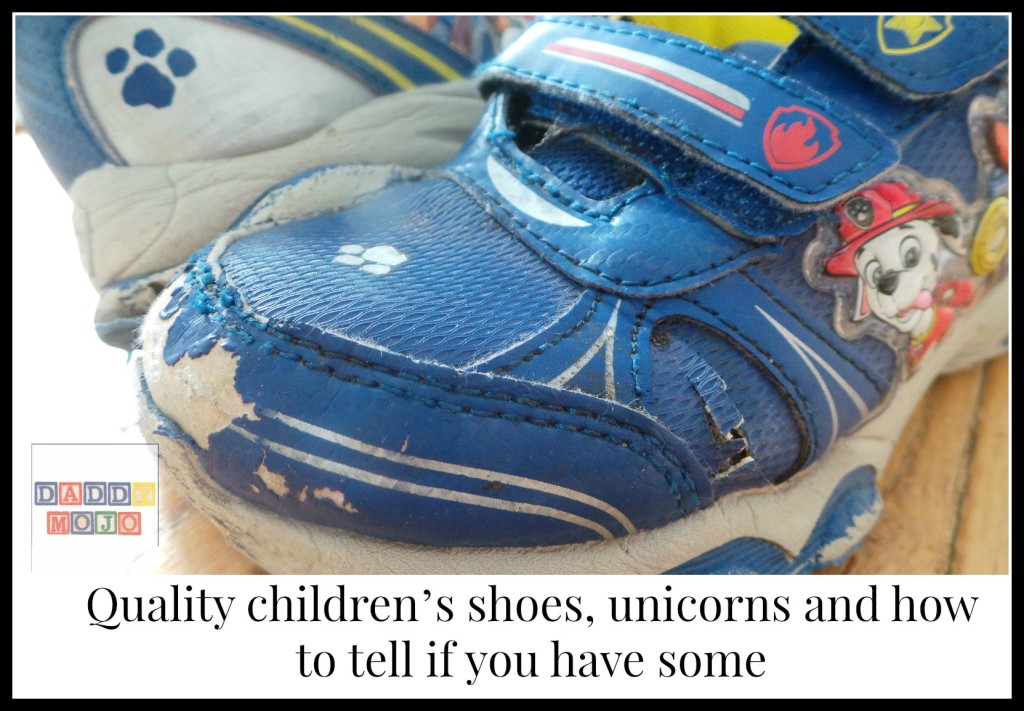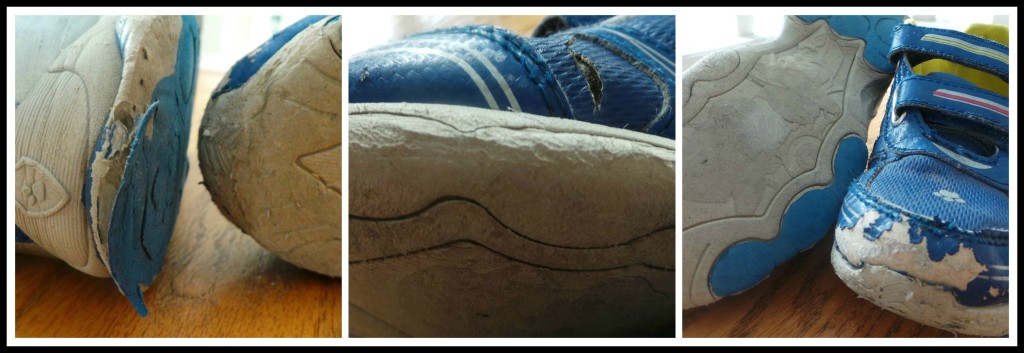We have two boys, aged 4 and 6. When Jake, our oldest turned 6 he needed a new pair of shoes. He’s active, but not one of those super active, plays three sports a day active. Picture the average kid, running around the yard, throwing the ball, riding the scooter and you get an idea as to how much wear he puts on his shoes. Any shoe will do and he’s keen into the light up shoes, so we went with Pup Patrol light ups that we bought at Target for $24. Within 15 days the shoes were beyond recognition, the bottom tread was entirely gone and there were multiple tears in the shoe itself. Here is what we learned about children’s shoes.
In hindsight we were hesitant to purchase name brand shoes because of the price. A casual look at prices for name brand children’s shoes had them starting at $60. My logic was that he’s only 6 years old-how quickly could he go through a pair of shoes without growing out of them? Besides, MY shoes cost just over $60 and the kids don’t need some vanity shoes to go to school in, they’re only 4 and 6.
After realizing that his shoes were garbage we knew that his expensive (in our mind) shoes weren’t a want, but a need. We’d pay for it one way or the other, buy him three pairs of the cheap shoes and he still might need a fourth pair during the life span of the expensive shoes. Case in point, he’s three weeks into his Under Armour shoes that cost $62. They’re wearing fine, he likes them, wishes that they lit up like the Pup Patrol shoes he had for 15 days, but understands a little more now.
I grew up at the onset of children getting expensive shoes. It was teens, my peers, or more likely, their parents, buying them $150 or more shoes. Even as a teen that made no sense to me. As an investment I can understand it-if you don’t wear them. However in my case and time, the teens were wearing them.
Now-as a parent I didn’t want our children to start that slippery slide towards entitlement teen-dom , shoes that cost too much, walking across my lawn and playing their video games too loud. OK, most of the previous statement was true, but shouldn’t even bad quality shoes last longer than 15 days?
At this age, it’s a combination of the price and quality of the shoes. The shoes that we purchased at Target weren’t bad because of where we bought them; they’re just bad shoes for his age. The light-up, cute shoes might be good for older children but it depends on the quality of the sole. The shoes that fell apart after 15 days had a mostly foam sole. The difference is simple to distinguish, once you know what to feel for. For example, in the below photos the gray sole is soft and can be pushed in with ease. The blue is harder than the gray, but not as hard as the rubber in more expensive shoes.
Foam will squeeze much easier that rubber. A rubber sole is harder and feels like rubber, it’s also a fabulous Beatles album. The difference in the sole of a children’s shoe is invaluable. If your child is active, even marginally active, they’ll burn through the foam sole very quickly.
If that’s the case then you’re best getting the name brand shoes. Their price is more than you want to pay; but from here out those shoes on your child’s feet is a need, not a want. They’ll still grow-and they’ll grow out of this pair of $65 shoes, but they’ll last longer than multiple pairs of the cheaper shoes you’ll purchase elsewhere.







 Facebook
Facebook Twitter
Twitter Flickr
Flickr GooglePlus
GooglePlus Youtube
Youtube